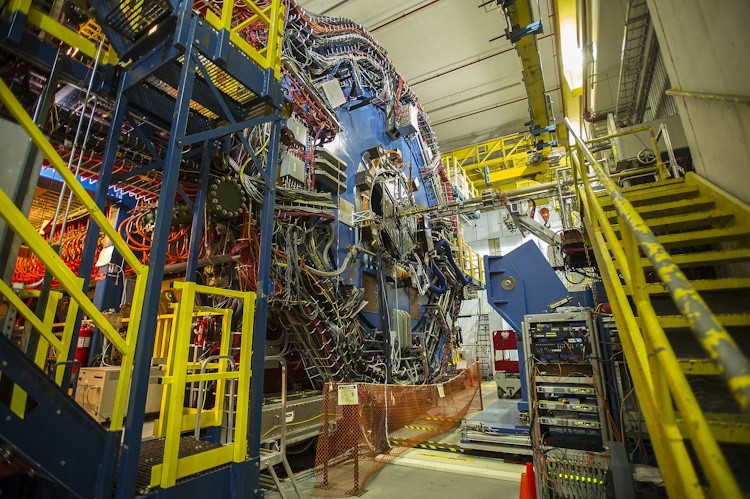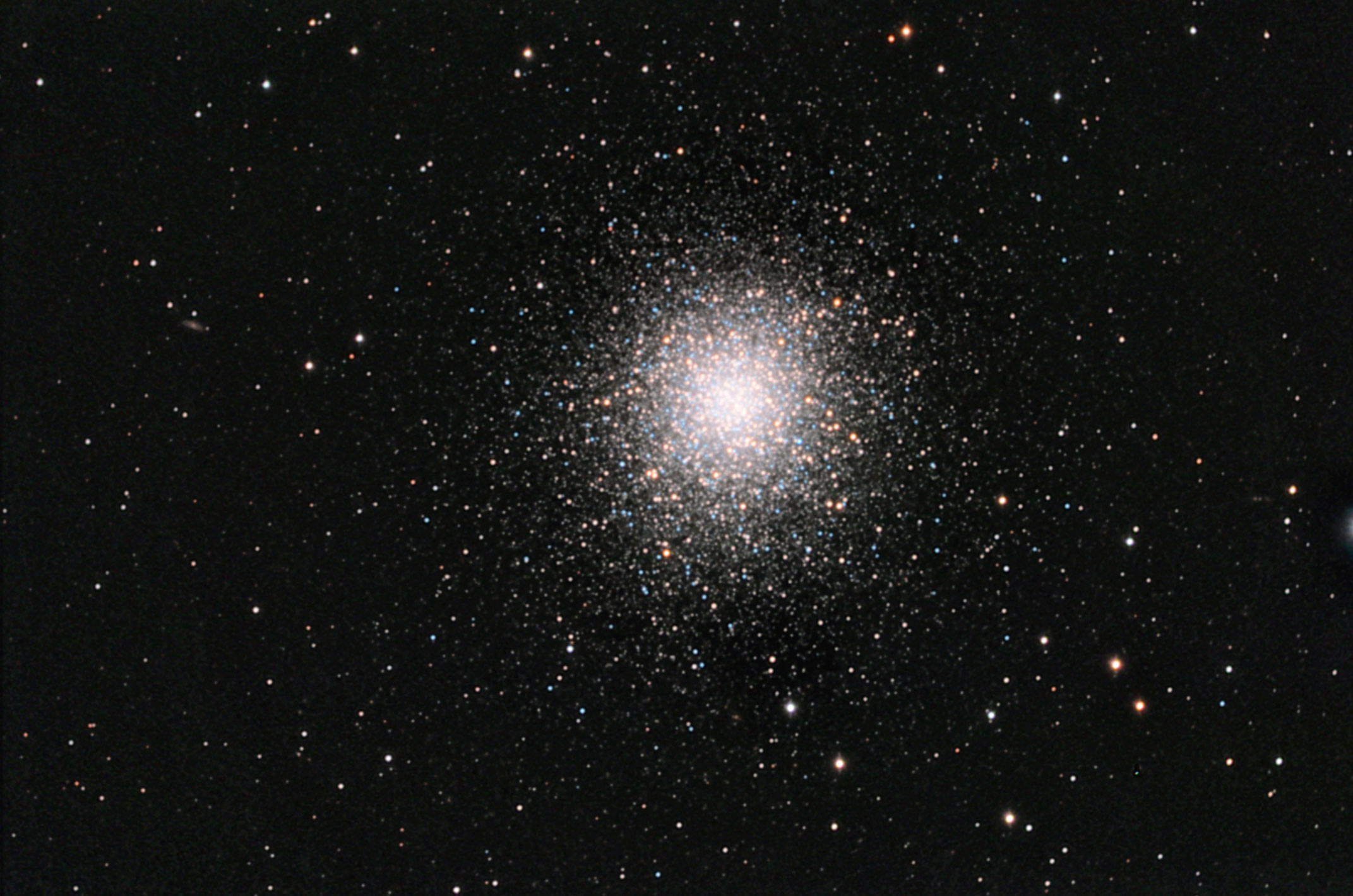Let There Be Light… Next Let There Be Matter – Photon Collider Creates Matter from Pure Light

The STAR detector at the Relativistic Heavy Ion Collider (RHIC) measured the angular distribution of particles produced in glancing collisions of gold ions moving at nearly the speed of light to provide evidence for a physics phenomenon predicted more than 80 years ago. In 1934, physicists Gregory Breit and John Wheeler predicted that collisions of photons could create matter and antimatter, and they even suggested doing so by accelerating heavy ions. The Relativistic Heavy Ion Collider at the Brookhaven National Laboratory turned out to be the ideal facility for testing their prediction. Nuclear physicists studied thousands of electron-positron pairs produced in near-miss collisions, where only the photons interacted. Researchers measured all available motion properties of the electron-positron pairs. By correlating the photons’ momentum, spatial location, and polarization with experimental observables, they found that the high-precision data was consistent with particles being generated by real photon interactions. The analysis provides solid evidence for the Breit-Wheeler effect. (Image Credit: Brookhaven National Laboratory)
Let There Be Light… Next Let There Be Matter – Photon Collider Creates Matter from Pure Light
Nuclear reactions in the Sun and in nuclear power plants regularly convert matter into energy. Now, using Einstein’s famous E = mc² equation in reverse, scientists have converted light energy directly into matter. Scientists used the Relativistic Heavy Ion Collider (RHIC) at the Brookhaven National Laboratory in Upton, New York, to create matter directly from collisions of light. Gregory Breit and John A. Wheeler predicted this process in 1934, but it has never been achieved in a single direct step. The researchers accelerated two beams of heavy gold ions to close to the speed of light in opposite directions. At such speeds, each gold ion is surrounded by packets of light (that is, real photons) generated by the ion’s perpendicular magnetic and electric fields. When the ions graze past one another without colliding, the photons interact to produce electrons (matter) and positrons (antimatter). The momentum and angular distributions of the resulting electron-positron pairs indicate, within the high-precision limits of the experiment, that these particles come from real photons. This makes the experiment a direct demonstration of the Breit-Wheeler effect.
Scientists studying particle collisions at the Relativistic Heavy Ion Collider (RHIC), a US Department of Energy Office of Science facility for nuclear physics research at the Brookhaven National Laboratory, have produced definitive evidence for a phenomenon predicted more than 80 years ago. The results were derived from a detailed analysis of more than 6000 pairs of electrons and positrons produced in glancing particle collisions at the RHIC.
The primary finding is that pairs of electrons and positrons, particles of matter and antimatter, can be created directly by colliding very energetic photons. This conversion of energetic light into matter is a direct consequence of Einstein’s famous E=mc2 equation, which states that energy and matter (or mass) are interchangeable. Now scientists have converted light energy directly into matter in a single step using RHIC’s STAR detector (Solenoid Tracker at RHIC) to measure the angular distribution of particles produced in glancing collisions of gold ions moving at nearly the speed of light.
Such capabilities didn’t exist when physicists Gregory Breit and John A. Wheeler first described the hypothetical possibility of colliding light particles to create pairs of electrons and their antimatter counterparts, known as positrons, in 1934.
If you try to replicate this photon-colliding experiment at home by crossing the beams of two laser pointers, you won’t be able to create new, massive particles. Instead, you’ll see the two beams combine to form an even brighter beam of light.
“If you read the equation E=mc² from right to left, you’ll see that a small amount of mass produces a huge amount of energy because of the c² constant, which is the speed of light squared,” says Alessandro Tricoli, a researcher at Brookhaven National Laboratory. “But if you look at the formula the other way around, you’ll see that you need to start with a huge amount of energy to produce even a tiny amount of mass.”
“In their paper, Breit and Wheeler already realized this is almost impossible to do,” said Brookhaven Lab physicist Zhangbu Xu, a member of RHIC’s STAR Collaboration. “Lasers didn’t even exist yet! But Breit and Wheeler proposed an alternative: accelerating heavy ions. And their alternative is exactly what we are doing at RHIC.”
An ion is essentially a naked atom, stripped of its electrons. A gold ion, with 79 protons, carries a powerful positive charge. Accelerating such a charged heavy ion to very high speeds generates a powerful magnetic field that spirals around the speeding particle as it travels, like current flowing through a wire.
“If the speed is high enough, the strength of the circular magnetic field can be equal to the strength of the perpendicular electric field,” Xu said. And that arrangement of perpendicular electric and magnetic fields of equal strength is exactly what a photon is -- a quantized packet of light. “So, when the ions are moving close to the speed of light, there are a bunch of photons surrounding the gold nucleus, traveling with it like a cloud.”
At RHIC, scientists accelerate gold ions to 99.995% of the speed of light in two accelerator rings.
“We have two clouds of photons moving in opposite directions with enough energy and intensity that when the two ions graze past each other without colliding, those photon fields can interact,” Xu said.
STAR physicists tracked the interactions and looked for the predicted electron-positron pairs.
But such particle pairs can be created by a range of processes at RHIC, including through “virtual” photons, a state of photon that exists briefly and carries an effective mass. To be sure the matter-antimatter pairs were coming from real photons, scientists have to demonstrate that the contribution of “virtual” photons does not change the outcome of the experiment.
To do that, the STAR scientists analyzed the angular distribution patterns of each electron relative to its partner positron. These patterns differ for pairs produced by real photon interactions versus virtual photons.
“We also measured all the energy, mass distributions, and quantum numbers of the systems. They are consistent with theory calculations for what would happen with real photons,” said Daniel Brandenburg, a Goldhaber Fellow at Brookhaven Lab, who analyzed the STAR data on this discovery.
“In the past, other scientists have tried to create electron-positron pairs from collisions of light using powerful lasers -- focused beams of intense light. But the individual photons within those intense beams didn’t have enough energy,” Brandenburg said.
“Our results provide clear evidence of direct, one-step creation of matter-antimatter pairs from collisions of light as originally predicted by Breit and Wheeler,” Brandenburg said. “Thanks to RHIC’s high-energy heavy ion beam and the STAR detector’s large acceptance and precision measurements, we are able to analyze all the kinematic distributions with high statistics to determine that the experimental results are indeed consistent with real photon collisions.”
For more information:
https://www.bnl.gov/newsroom/news.php?a=119023
https://science.osti.gov/np/Highlights/2022/NP-2022-01-a
https://newscenter.lbl.gov/2020/09/23/lhc-creates-matter-from-light/
https://cmsexperiment.web.cern.ch/news/lhc-photon-collider
https://journals.aps.org/prl/abstract/10.1103/PhysRevLett.131.065102
Astromart News Archives:
https://www.astromart.com/news/search?category_id=3&q=.
Check out some of my favorite Words of Wisdom:
https://astromart.com/news/show/words-of-wisdom-my-favorite-quotable-quotes
https://astromart.com/news/show/words-of-wisdom-my-favorite-proverbs-from-around-the-world
Do you enjoy reading these postings?
Then click here and buy the Astromart staff a cup of coffee (and maybe even some donuts):
https://astromart.com/support-options
Funding Member
Sponsors
- OMI OPTICS USA LLC
- Anacortes Telescope
- BW
- BBLABS LLC
- Astromart Customer Service
- Matsumoto Company
- FocusKnobs
- Bob's Knobs
- ASTROPHOTOGRAPHY BY MARTIN PUGH
- AstroMart LLC
- RemoteSkies.net
- SellTelescopes.com
- Waite Research
- Rouz Astro
- astronomy-shoppe
- Desert Sky Astro Products
- APM-Telescopes
View all sponsors



